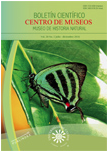Authors
Abstract
The aim of the present study was to localize, quantify and characterize the nests of the leaf cutting ants under two contrasting management systems in coffee areas of the municipalities of Popayan and Cajibio, Department of Cauca. Eight shaded coffee plantations, 8 free standing coffee plantations and 4 forest fragments were selected. At each site rounds were made and active search for nests was carried out; in each site individuals from different castes were collected and identified and soldiers were measured. The nests areas were calculated as well as the number and size of the foraging tracks, and the defoliated plants were recorded. The number and area of the nests were related to environmental variables and the size of soldiers in the nest area was correlated. A total of 276 individuals form Atta cephalotes was collected. Four nests were recorded in forest fragments, eight in shaded coffee plantations and nine in free standing coffee plantations. Nest areas varied between 0.90 and 758.34 m², with trails from 1 to 32 m length. The area of the nests located in free standing coffee plantations showed significant differences in relation to nests located in shaded coffee plantations and in forest fragments, the latter being the largest ones. A positive correlation between size of the nests and tree richness, canopy cover and thickness of fallen leaves was found, while it was inversely correlated with room temperature. The width of the head was positively correlated with the area of the nests. A total of 32 plant species with signs of defoliation by A. cephalotes was recorded confirming the general habit of these species. The importance of maintaining species associated to the coffee crop as alternative resources and for the protection of the ant foraging is highlighted.
Keywords
References
BOLLAZZI, M. & ROCES, F., 2002.- Thermal preference for fungus culturing and brood location by workers of the thatching grass-cutting ant Acromyrmex heyeri. Insectes Soc., 49, 153-157.
BOLLAZZI, M. & ROCES, F., 2007.- To build or not to build: circulating dry air organizes collective building for climate control in the leaf-cutting ant. Acromyrmex ambiguus. Anim. Behav., 74, 1349-1355.
CABALLERO-GEORGE, P., VANDERHEYDEN, M.L., SOLIS, P. N., PIETERS, L., SHAHAT, A.A., GUPTA, M.P., VAUQUELIN, G. & VLIETINCK, A.J., 2001.- Biological screening of selected medicinal Panamanian plants by radioligand-binding techniques. Phytomedicine, 8(1): 59-70.
DELLA LUCIA, T.M.C., 2011.- Formigas-cortadeiras: da bioecologia ao manejo. Viçosa, M.G: Ed. Universidade Federal de Viçosa.
ESCOBAR DURÁN, R., GARCÍA COSSIO, F., RENTERÍA, N.Y. & NEITA M, J.C., 2002.- Manejo y control de hormiga arriera (Atta spp. & Acromyrmex spp.) en sistemas de producción de importancia económica en el departamento del Chocó. Cartilla 1 y 2. Ministerio de Agricultura - PRONATTA - Universidad Tecnológica del Chocó. CO.
ESPINAL, L.S., 1968.- Apuntes sobre ecología colombiana. Universidad del Valle. Departamento de Biología. Cali.
FERNÁNDEZ, F.; CASTRO-HUERTAS, V. & SERNA, F., 2015.- Hormigas cortadoras de hojas de Colombia: Acromyrmex & Atta (Hymenoptera: Formicidae). Fauna de Colombia, Monografía No.5, Instituto de Ciencias Naturales, Universidad Nacional de Colombia, Bogotá D.C., Colombia.
FORTI, L.C., MOREIRA, A.A., ANDRADE, A.P., CASTELLANI, M.A. & CALDATO, N., 2011.- Nidificão e Arquitectura de Ninhos de Formigas-Cortadeiras. Capítulo 6: 102-125 (en) Formigas-Cortadeiras da bioecologia ao manejo, Della Lucia T. M. C. (ed.). Viçosa, MG: Ed. UVF.
FOWLER, H.G., FORTI, L.C., PEREIRA-DA-SILVA, V. & SAES, N.B., 1986.- Economics of Grass Cutting Ants: 18. (en) Lofgren. S. C & Vander M. R. K (eds). Fire ants and leaf- cuting ants. Biology and Management. Westview Press.
HÖLLDOBLER, B. & WILSON, E.O., 1990.- The Ants. The Belknap Press of Harward University Press, Cambridge, MA, USA.
HÖLLDOBLER, B. & E.O. WILSON., 2011.- The Leafcutter Ants: Civilization by Instinct. W. W. Norton & Co. Ltd.
MACKAY, W.P. & MACKAY, E.E., 1986.- Las hormigas de Colombia: arrieras del género Atta. Revista Colombiana de Entomología 12: 23-30.
MEYER, S.T., 2008.- Ecosystem engineering in fragmented forests. Edge-mediated hyper abundance of leaf-cutting ants and resulting impacts on forest structure, micro-climate and regeneration. PhD thesis dissertation. Technical University Kaiserslautern, Germany. 159pp.
MONTOYA-LERMA, J., GIRALDO-ECHEVERRI C., ARMBRECHT, I., FARJI-BRENER, A. & CALLE, Z., 2012.- Leaf-cutting ants revisited: Towards rational management and control. International Journal of Pest Management 58 (3): 225-247.
MOREIRA, A.A., FORTI, L.C., ANDRADE, A.P.P., BOARETTO, M.A.C. & LOPES, J.F.S., 2004.- Nest architecture of Atta laevigata (F. Smith, 1858) (Hymenoptera: Formicidae). Studies on Neotropical Fauna and Environment, 39 (2): 109-116.
OCAMPO, D.M., VALVERDE, C.L., COLMENARES, A.J., & ISAZA, J.H., 2014.- Fenoles totales y actividad antioxidante en hojas de dos especies colombianas del género Meriania (Melastomataceae). Rev. Colomb. Quim., 43 41-46.
ORTIZ, A. & GUZMÁN, G.E., 2007.- Las hormigas cortadoras de hojas en el departamento de Antioquia. Universidad de Antioquia, Secretaría de Agricultura de Antioquia, Gobernación de Antioquia, Universidad Nacional de Colombia, Medellín, Colombia.
RASBAND, W.S., 1997-2014.- ImageJ. U. S. National Institutes of Health, Bethesda, MD. Disponible en: http://imagej.nih.gov/ij/.
R CORE TEAM., 2015. R: A language and environment for statistical computing. R Foundation for Statistical Computing. Viena, Austria. Disponible en: http://www.R-project.org/.
SANTOS-OLIVEIRA, M.F.S., 2006.- Controle de formigas cortadeiras (Hymenoptera: Formicidae) com produtos naturais. Tese de doutorado em Ciências Biológicas. Universidad Estatal Paulista "Julio de Mesquita Filho", Rio Claro, Brasil.
VARÓN, E. H., EIGENBRODE, S. D., BOSQUE-PÉREZ, N. A. & HILJE, L., 2007.- Effect of farm diversity on harvesting of coffee leaves by the leaf-cutting ant Atta cephalotes. Agricultural and Forest Entomology 9: 47-55.
VARGAS, W.G., 2002.- Guía ilustrada de las plantas de las montañas del Quindío y los Andes Centrales. Colección Ciencias Agropecuarias. Universidad de Caldas. Editorial Illustrated.
VÁSQUEZ, M.R., 1997.- Flórula de las Reservas Biológicas de Iquitos, Perú. Allpahuayo-Mishana, Explornapo Camp, Explorama Lodge. Monogr. Missouri Bot. Gard., 63: 54-55.
VÉLEZ, R. 1997. Plagas agrícolas de impacto económico en Colombia: bionomía y manejo integrado. Segunda edición. Editorial Universidad de Antioquia, Medellín, Colombia.
WEBER, N.A., 1972.- The Attines: The fungus-culturing Ants. American Scientist, 60: 448.
ZANETTI, R., 2007.- Manejo integrado de formigas cortadeiras e cupins em áreas de eucalipto da Cenibra. Laudo técnico FSC-Cenibra. Departamento de Entomologia, Universidade Federal de Lavras, Brasil.

 PDF (Español)
PDF (Español)
 FLIP
FLIP






















